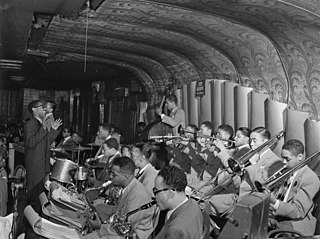
The Savoy Ballroom was a large ballroom for music and public dancing located at 596 Lenox Avenue, between 140th and 141st Streets in the Harlem neighborhood of Manhattan, New York City. Lenox Avenue was the main thoroughfare through upper Harlem. Poet Langston Hughes calls it the "Heartbeat of Harlem" in Juke Box Love Song, and he set his work "Lenox Avenue: Midnight" on the legendary street. The Savoy was one of many Harlem hot spots along Lenox, but it was the one to be called the "World's Finest Ballroom". It was in operation from March 12, 1926, to July 10, 1958, and as Barbara Englebrecht writes in her article "Swinging at the Savoy", it was "a building, a geographic place, a ballroom, and the 'soul' of a neighborhood". It was opened and owned by white entrepreneur Jay Faggen and Jewish businessman Moe Gale. It was managed by African-American businessman and civic leader Charles Buchanan. Buchanan, who was born in the British West Indies, sought to run a "luxury ballroom to accommodate the many thousands who wished to dance in an atmosphere of tasteful refinement, rather than in the small stuffy halls and the foul smelling, smoke laden cellar nightclubs ..."
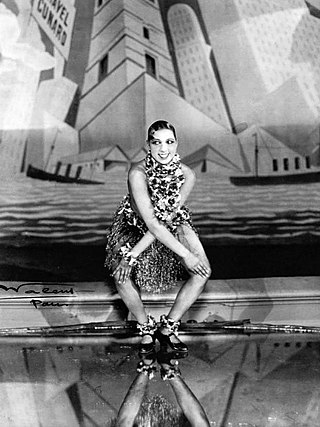
The Charleston is a dance named after the harbor city of Charleston, South Carolina. The rhythm was popularized in mainstream dance music in the United States by a 1923 tune called "The Charleston" by composer/pianist James P. Johnson, which originated in the Broadway show Runnin' Wild and became one of the most popular hits of the decade. Runnin' Wild ran from 28 October 1923 through 28 June 1924. The Charleston dance's peak popularity occurred from mid-1926 to 1927.

Swing dance is a group of social dances that developed with the swing style of jazz music in the 1920s–1940s, with the origins of each dance predating the popular "swing era". Hundreds of styles of swing dancing were developed; those that have survived beyond that era include Charleston, Balboa, Lindy Hop, and Collegiate Shag. Today, the best-known of these dances is the Lindy Hop, which originated in Harlem in the early 1930s. While the majority of swing dances began in African-American communities as vernacular African-American dances, some influenced swing-era dances, like Balboa, developed outside of these communities.

The Shim Sham Shimmy,Shim Sham or just Sham originally is a particular tap dance routine and is regarded as tap dance's national anthem. For today's swing dancers, it is a line dance.
The Big Apple is both a partner dance and a circle dance that originated in the Afro-American community of the United States in the beginning of the 20th century.

Jitterbug is a generalized term used to describe swing dancing. It is often synonymous with the lindy hop dance but might include elements of the jive, east coast swing, collegiate shag, charleston, balboa and other swing dances.

Frank Manning was an American dancer, instructor, and choreographer. Manning is considered one of the founders of Lindy Hop, an energetic form of the jazz dance style known as swing.

The Hot Shots is a collective name for two closely related Swedish dance companies based in Stockholm, Sweden: The Rhythm Hot Shots and the Harlem Hot Shots. The Hot Shots specialize in faithful reproductions of African-American dance scenes in American films from the 1920s, 30s, and 40s. Dances that they perform include Lindy Hop, Tap dance, Cakewalk, Charleston, and Black Bottom. The members of the Hot Shots are also respected dance instructors and accomplished social dancers. The goals of The Rhythm Hot Shots and the Harlem Hot Shots are the same.

The Tranky Doo is a jazz dance choreography.
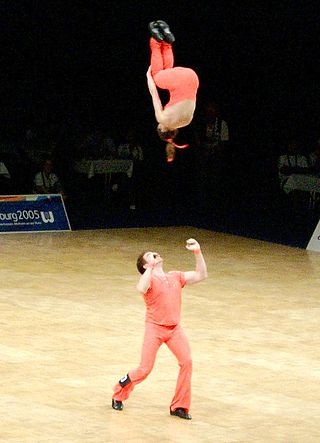
Acrobatic rock and roll is a fast, athletic, physically demanding form of partner dance that originated from Lindy Hop but has evolved to a choreographed sport, often done in formal competition. It is danced by both couples and groups, either all-female or four to eight couples together.
Whitey's Lindy Hoppers was a professional performing group of exceptional swing dancers that was first organized in the late 1920s by Herbert "Whitey" White in the Savoy Ballroom and disbanded in 1942 after its male members were drafted into World War II. The group took on many different forms and had several different names and sub-groups, including Whitey's Hopping Maniacs, Harlem Congeroo Dancers, and The Hot Chocolates. In addition to touring nationally and internationally, the group appeared in several films and Broadway theatre productions. Dorothy Dandridge and Sammy Davis Jr. were among the group's celebrity regulars.
Al Minns, was a prominent American Lindy Hop and jazz dancer. Most famous for his film and stage performances in the 1930s and 1940s with the Harlem-based Whitey's Lindy Hoppers, Minns worked throughout his life to promote the dances that he and his cohorts helped to pioneer at New York's Savoy Ballroom. In 1938, Al Minns and Sandra Gibson won the Harvest Moon Ball.
George "Shorty" Snowden was an African American dancer in Harlem during the 1920s and 1930s. He and his partner Mattie Purnell invented the Harlem Lindy Hop in the dance marathon at Harlem's Rockland Palace between June and July 1928. Snowden and Purnell's invention was based on the breakaway pattern which they practically rediscovered via an accident in the dance marathon.

The history of Lindy Hop begins in the African American communities of Harlem, New York during the late 1920s in conjunction with swing jazz. Lindy Hop is closely related to earlier African American vernacular dances but quickly gained its own fame through dancers in films, performances, competitions, and professional dance troupes. It became especially popular in the 1930s with the upsurge of aerials. The popularity of Lindy Hop declined after World War II, and it converted to other forms of dancing, but it never disappeared during the decades between the 1940s and the 1980s until European and American dancers revived it starting from the beginning of the 1980s.
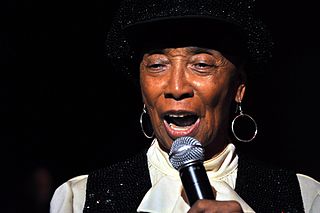
Norma Adele Miller was an American Lindy hop dancer, choreographer, actress, author, and comedian known as the "Queen of Swing".

Herräng Dance Camp is the largest annual dance camp that focuses on lindy hop, boogie woogie, tap dance, jazz dance, and balboa. It is held annually in July in Herräng, Sweden, and focuses both on instruction and dancing.
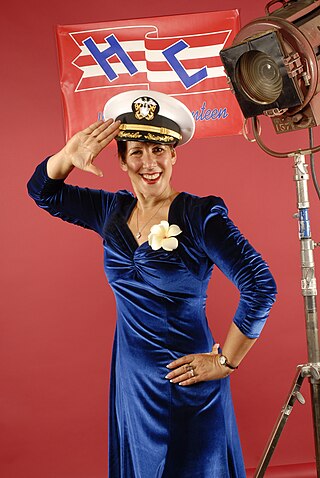
Rusty Frank is an American tap dancer, producer, writer, choreographer, lindy hopper, and dance preservationist.
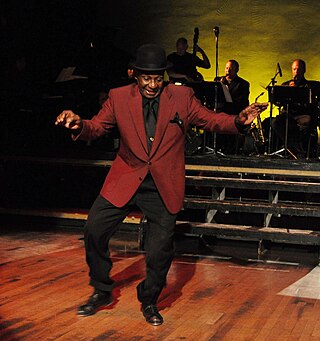
Charles "Chazz" Young is an American choreographer and teacher of tap dance.

The Lindy Hop is an American dance which was born in the African-American communities of Harlem, New York City, in 1928 and has evolved since then. It was very popular during the swing era of the late 1930s and early 1940s. Lindy is a fusion of many dances that preceded it or were popular during its development but is mainly based on jazz, tap, breakaway, and Charleston. It is frequently described as a jazz dance and is a member of the swing dance family.
Willa Mae Ricker was a prominent American Lindy Hop and jazz dancer and performer during the 1930s and 1940s with the Harlem-based Whitey's Lindy Hoppers. She was known for her physical strength, fashion sense, dependability, business acumen, and passion to dance. According to Norma Miller, Ricker was the first dancer to stand up to Herbert "Whitey" White, demanding fair pay.






















